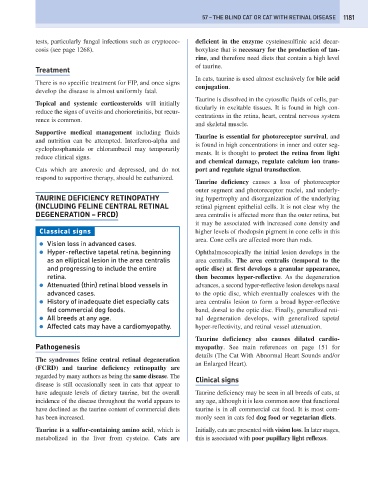Page 1189 - Problem-Based Feline Medicine
P. 1189
57 – THE BLIND CAT OR CAT WITH RETINAL DISEASE 1181
tests, particularly fungal infections such as cryptococ- deficient in the enzyme cysteinesulfinic acid decar-
cosis (see page 1268). boxylase that is necessary for the production of tau-
rine, and therefore need diets that contain a high level
of taurine.
Treatment
In cats, taurine is used almost exclusively for bile acid
There is no specific treatment for FIP, and once signs
conjugation.
develop the disease is almost uniformly fatal.
Taurine is dissolved in the cytosolic fluids of cells, par-
Topical and systemic corticosteroids will initially
ticularly in excitable tissues. It is found in high con-
reduce the signs of uveitis and chorioretinitis, but recur-
centrations in the retina, heart, central nervous system
rence is common.
and skeletal muscle.
Supportive medical management including fluids
Taurine is essential for photoreceptor survival, and
and nutrition can be attempted. Interferon-alpha and
is found in high concentrations in inner and outer seg-
cyclophosphamide or chlorambucil may temporarily
ments. It is thought to protect the retina from light
reduce clinical signs.
and chemical damage, regulate calcium ion trans-
Cats which are anorexic and depressed, and do not port and regulate signal transduction.
respond to supportive therapy, should be euthanized.
Taurine deficiency causes a loss of photoreceptor
outer segment and photoreceptor nuclei, and underly-
TAURINE DEFICIENCY RETINOPATHY ing hypertrophy and disorganization of the underlying
(INCLUDING FELINE CENTRAL RETINAL retinal pigment epithelial cells. It is not clear why the
DEGENERATION – FRCD) area centralis is affected more than the outer retina, but
it may be associated with increased cone density and
Classical signs higher levels of rhodopsin pigment in cone cells in this
area. Cone cells are affected more than rods.
● Vision loss in advanced cases.
● Hyper-reflective tapetal retina, beginning Ophthalmoscopically the initial lesion develops in the
as an elliptical lesion in the area centralis area centralis. The area centralis (temporal to the
and progressing to include the entire optic disc) at first develops a granular appearance,
retina. then becomes hyper-reflective. As the degeneration
● Attenuated (thin) retinal blood vessels in advances, a second hyper-reflective lesion develops nasal
advanced cases. to the optic disc, which eventually coalesces with the
● History of inadequate diet especially cats area centralis lesion to form a broad hyper-reflective
fed commercial dog foods. band, dorsal to the optic disc. Finally, generalized reti-
● All breeds at any age. nal degeneration develops, with generalized tapetal
● Affected cats may have a cardiomyopathy. hyper-reflectivity, and retinal vessel attenuation.
Taurine deficiency also causes dilated cardio-
Pathogenesis myopathy. See main references on page 151 for
details (The Cat With Abnormal Heart Sounds and/or
The syndromes feline central retinal degeneration
an Enlarged Heart).
(FCRD) and taurine deficiency retinopathy are
regarded by many authors as being the same disease. The
Clinical signs
disease is still occasionally seen in cats that appear to
have adequate levels of dietary taurine, but the overall Taurine deficiency may be seen in all breeds of cats, at
incidence of the disease throughout the world appears to any age, although it is less common now that functional
have declined as the taurine content of commercial diets taurine is in all commercial cat food. It is most com-
has been increased. monly seen in cats fed dog food or vegetarian diets.
Taurine is a sulfur-containing amino acid, which is Initially, cats are presented with vision loss. In later stages,
metabolized in the liver from cysteine. Cats are this is associated with poor pupillary light reflexes.

